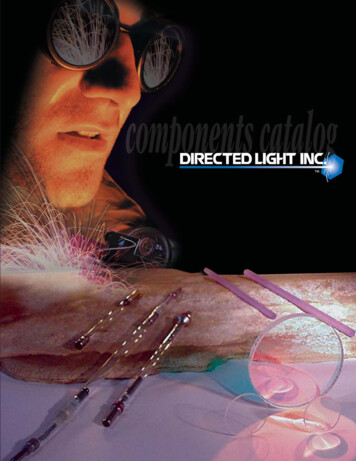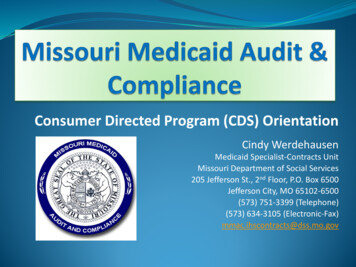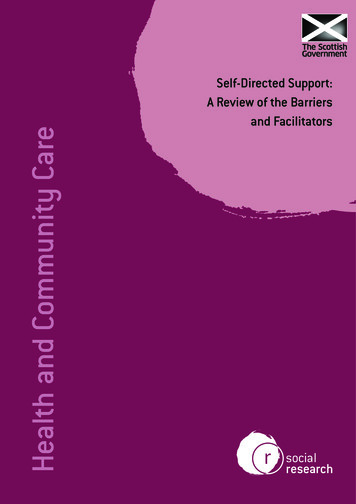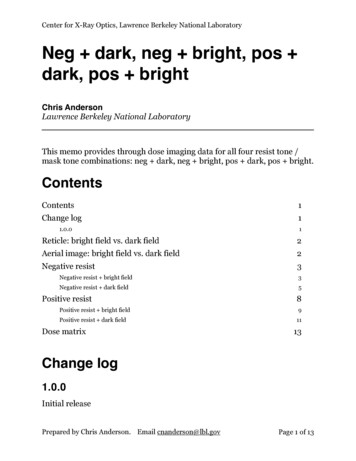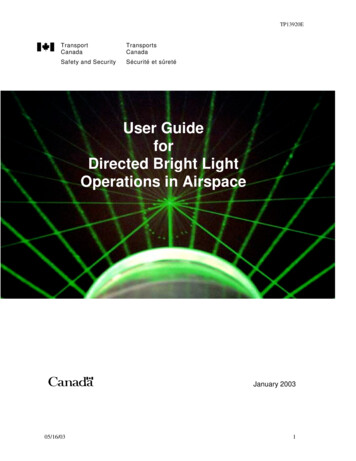
Transcription
TP13920ETransportCanadaTransportsCanadaSafety and SecuritySécurité et sûretéUser GuideforDirected Bright LightOperations in AirspaceJanuary 200305/16/031
TP13920ECover Photo :The permanent laser installation at Shaw Millennium Park, CalgaryAB. Photo courtesy of Laser Fantasy International05/16/032
TP13920ETABLE OF CONTENTS1.0 Outdoor Directed Bright Light Operations in Airspace1.1 Purpose 1.2 Regulations .1.3 Authority 1.4 Policy . 1.5 Responsibilities . 1.6 Definitions . 5566692.0 Outdoor Laser Operations2.1 Airspace Restrictions .2.2 Airspace Restrictions .2.3 Aeronautical Assessment Process .2.4 Determinations 131517173.0 Other Outdoor Directed Bright Light Operations3.1 Purpose 3.2 Definitions 3.3 Policy 3.4 Notice of Operations 3.5 Aeronautical Assessment 1919202020Appendix A – Notice of Proposal to Conduct Outdoor laser Operations Appendix B – Notice of Outdoor Directed Bright Light Equipment Parameters.Appendix C– Transport Canada Regions and List of Contacts 21414505/16/033
TP13920E05/16/034
TP13920EDIRECTED BRIGHT LIGHT OPERATIONS IN AIRSPACE1.01.1 PURPOSEThe purpose of this document is to provide Proponents with guidance on the procedures forobtaining an aviation risk assessment of their outdoor directed bright light (DBL) operations.The effect of projected light, particularly coherent light, on the vision of aviation crews is a seriouspotential hazard to aviation safety. The possible effects are flashblindness, afterimage and glare.At a minimum these effects are a distraction and worst case could cause a major accident.By following these guidelines, Proponents will be advised what control measures to use to ensurethat their outdoor display will safely co-exist with aircraft operations in the vicinity.1.2 REGULATIONSEffective 1 June 2002, the following regulations have been adopted and incorporated into theCanadian Aviation Regulations (CARs).Projection of Directed Bright Light Source at an AircraftCARs 601.20 Subject to section 601.21, no person shall project or cause to be projected adirected bright light source into navigable airspace in such a manner as to create a hazard toaviation safety, damage to an aircraft or injury to persons on board the aircraft.Requirement for NotificationCARs 601.21 (1) Any person planning to project or cause to be projected a directed brightlight source into navigable airspace with sufficient power to create a hazard to aviation safetyshall provide written notification to the Minister before the projection.(2) On receipt of the notification, the Minister may issue an authorization if the projection ofthe directed bright light source is not likely to create a hazard to aviation safety.Requirement for Pilot-in-commandCARs 601.22 (1) No pilot-in-command shall intentionally operate an aircraft into a beamfrom a directed bright light source or into an area where a directed bright light source isprojected, unless the aircraft is operated in accordance with an authorization issued by theMinister.(2) The Minister may issue the authorization if the operation of the aircraft is not likely tocreate a hazard to aviation safety.05/16/035
TP13920EIn support of these regulations, this document is a guide to Proponents for the submission of displayproposals. By notification of the proposed operation, Transport Canada in co-ordination with NAVCANADA and Health Canada, will be able to assess the risk to aviation and propose controlmeasures to the Proponent to counter any determined risks.05/16/036
TP13920E1.3 AUTHORITYThe Minister of Transport is the statutory authority and is responsible for the development ofaeronautical regulations and the supervision of all matters connected with aeronautics.The Civil Air Navigation Commercialization Act provides NAV CANADA the authority for theprovision of air navigation services in Canada.1.4 POLICYTransport Canada will make every effort to respect the right of directed bright light operators toconduct their business. However, full consideration must be given to commercial, general andmilitary aviation operations that have the public right of freedom to transit through Canadianairspace. Accordingly, while a sincere effort shall be made to negotiate equitable solutions toconflicts over the use for non-aviation purposes, aviation safety must receive first priority.Transport Canada will conduct aeronautical assessments of proposed outdoor DBL operations andwill establish appropriate control measures to assure safe co-existence of aviation and DBLoperations.1.5 RESPONSIBILITIESTransport Canada, on behalf of the Minister, is responsible for the development of regulations andto provide safety oversight of the aeronautical process to ensure aviation safety during outdoor DBLoperations.For any planned outdoor directed bright light activity that has the potential to adversely affect usersof the navigable airspace, Transport Canada shall coordinate with the Proponent to mitigatepotential hazards.NAV CANADA, as the air navigation service provider, shall assist and provide input to TransportCanada as part of the aeronautical assessment of outdoor DBL operations.Health Canada is responsible for providing health and safety recommendations regarding lasersand other directed bright light sources. Health Canada will continue to monitor safety requirementsand validate “Notice of Proposal” hazard distance calculations.05/16/037
TP13920E05/16/038
TP13920E1.6 Definitions.Afterimage: A reverse contrast shadow image left in the visual field after an exposure to a bright light.Canadian Domestic Airspace (CDA): All navigable airspace of Canada designated and defined assuch in the Designated Airspace Handbook (DAH).Critical Zone Exposure Distance (CZED): The distance along the axis of the beam to the human eyealong which irradiance is not expected to exceed 5µW/cm2.Divergence: Sometimes referred to as beam spread, divergence is the increase in the diameter of thelaser beam with distance from the exit aperture, based on the full angle at the point where theirradiance (or radiant exposure for pulsed lasers) is 1/e times the maximum value.Flashblindness: A visual interference effect that persists after the source of illumination has beenremoved.Flight Zones: Areas of airspace specifically designated to mitigate the potential hazardous effect oflaser radiation. These areas may not be contiguous or concentric with other zones.(See Figures 2.2 – 2.5)1. Laser Free Zone (LFZ). Airspace in the immediate proximity to the airport, up to and including2,000 feet AGL, extending 2 nautical miles in all directions measured from the runwaycenterline, plus an additional 3nm extension, 2,500 feet each side of the extended runwaycenterline of each useable runway surface. The level of laser light is restricted to a level thatshould not cause any visual disruption.(50nW/cm2).2. Critical Flight Zone (CFZ). Airspace within 10 nautical miles (NM) radius of the airportreference point (ARP), up to and including 10,000 feet AGL, where a level of laser light isrestricted to avoid flashblindness or afterimage effects (5µW/cm2).3. Sensitive Flight Zone (SFZ). Airspace outside the critical flight zone(s) that has been identifiedas requiring protection from flashblindness and afterimage effects (100µW/cm2). The SFZ neednot necessarily be contiguous with the other zones.4. Normal Flight Zones (NFZ). Airspace not defined by the Laser Free, Critical, or SensitiveFlight Zones.Joules (J): A unit of energy. 1 joule 1 watt second.Irradiance: Irradiance is a means of expressing the intensity of the beam. Generally, the power perunit area expressed in watts per square centimeter.Laser: A device that produces an intense, coherent, directional beam of light by stimulating electronicor molecular transitions to lower energy levels. An acronym for Light Amplification by StimulatedEmission of Radiation.05/16/039
TP13920ELaser Free Exposure Distance (LFED): The distance along a visible laser beam beyond which thelaser irradiance is not expected to cause any distraction to an individual performing critical tasks.Laser Manufacturer: Person(s) engaged in the business of manufacturing, modifying or assembly (toany extent) of laser equipment.Laser Operator:A knowledgeable person, present during laser operation, who has been givenauthority to operate the laser system in compliance with applicable safety standards, subject torecommendations of the LSO.Laser Safety Officer(LSO): One who has authority to monitor and enforce the control of laser hazardsand effect the knowledgeable evaluation and control of laser hazards.Local Laser Working Group (LLWG): When necessary, convened to assist the Transport CanadaRegional office in evaluating the potential effect of laser emissions on aircraft operators in the localvicinity of the proposed laser activity. Participants may include, but are not limited to,representatives from the tower, area control center, “non-federal” towers, airport management,airspace users, City/Regional/Provincial officials, Transport Canada, other government agencies,military representatives, qualified subject experts, laser manufacturers, the laser Proponent, etc.Maximum Permissible Exposure (MPE): The level of laser radiation to which a person may beexposed without hazardous effect or adverse biological changes in the eye or skin. In general MPE isexpressed as mW/cm² or mJ/cm².Milliradian (mrad): A measure of angle used for beam divergence. A milliradian is about 1/17th of adegree.Mitigation: Use of control measures that provide an equivalent or greater level of safety.Nominal Ocular Hazard Distance (NOHD): The maximum distance from the laser system beyondwhich the laser beam irradiance does not exceed the MPE for that laser.Notice to Airmen (NOTAM):A notice which contains information concerning the establishment,condition or change in any aeronautical facility, service, procedure or hazard, the timely knowledge ofwhich is essential to personnel concerned with flight operations.Proponent: Person(s) applying to conduct an outdoor laser operation at a specific time and location.Radiant exposure (H): Surface density of the radiant energy received. It is computed from the emittedenergy divided by the area of the laser beam. Unit: joules per square centimeter.Reflected beams:1. Diffuse: The component of a reflection from a surface which is incapable of producing a virtualimage such as is commonly found with flat finish paints or rough surfaces. A diffuse surface willreflect the laser beam in many directions.2. Specular: A mirror-like reflection that usually maintains the directional characteristics of thebeam.05/16/0310
TP13920EScanned laser radiation: Laser radiation having a time varying direction, origin, or pattern ofpropagation with respect to a stationary frame of reference.Sensitize Zone Exposure Distance (SZED): The distance along the axis of the unobstructed beamfrom the laser to the human eye beyond which the irradiance is not expected to exceed 100µW/cm2.Terminated Beam: An output from the laser projector which enters airspace and is confined by asuitable object that prohibits the continuation of the beam at levels above the applicable flight safelevel.Unterminated Beam: A laser beam which is directed or reflected into navigable airspace. Theproponent shall provide sufficient evidence to Health Canada and Transport Canada that users of theCDA are not affected.Variance: Permission from USA FDA for a laser manufacturer and/or operator to deviate from one ormore requirements of 21 CFR 1040 when alternate steps are taken to provide equivalent safety.Watt (W): A unit of measurement associated with the power output of a laser system. Often a fractionof a watt is prefixed with "milli-", "micro-", and "nano-". One watt is one joule per second.05/16/0311
TP13920E05/16/0312
TP13920E2.0: OUTDOOR LASER OPERATIONS2.1Airspace RestrictionsTo protect aviation operations in the vicinity of airports, aerodromes, heliports and other areas,airspace shall be protected against hazardous beams. For non-visible lasers, the nominal ocularhazard distance (NOHD) value is the sole consideration. For visible lasers, in addition to theNOHD, visual disruption shall also be considered.Figures 2.2 – 2.5 define the zones established for aircraft in navigable airspace. Protective means(mitigation) shall be used to protect personnel and pilots when a visual interference level isexceeded. A backup system of mitigation is advisable in locations noted for heavy air traffic.Airspace shall be designated as sensitive flight zones, critical flight zones, and laser-free zones,where visible laser beams should not interfere with a pilot’s vision, even if the MPE is notexceeded. All other airspace is designated as normal flight zones.The beam from a visible laser shall not enter any zone, when the irradiance is greater than thecorresponding visual interference level, unless adequate protective means are employed to preventpersonnel exposure. Lasers with a beam irradiance less than the MPE, but exceeding the sensitivelevel or critical level may be operated in the sensitive zone or critical zone, respectively, if adequatemeans are used to prevent aircraft from entering the beam path.FL IG HT ZO NESLaser Free Zone3nmSensitiveFlightZone2nm2nm3nmCritical Flight ZoneNote: Size of SFZ tobe determ ined byoperational requirem entsFigure 2.205/16/0313
TP13920ESensitiveFlight ZoneCriticalFlight zoneLaser Free Zone10nm10nmAirportReferencePointTo be determined based onoperational requirementsFigure 2.35NM2NM5000'2NM5NM2NM2NM2NM3NMLaser Free ZoneFigure 2.405/16/0314
TP13920EAIRSPACE FLIGHT ZONESTO BE DETERM INED BYLOCAL AIRPORT OPERATIONSTO BE DETERMINED BYLOCAL AIRPORT OPERATIONSELEVATIONSENSITIVE FLIGHT ZONE100 µ W /cm 28000’8000’CRITICAL FLIGHT ZONE5 µ W /cm 23nm2nm2000’2000’LASER FREE ZONE50nW /cm 22nm3nmRUNWAY LENGTH VARIES PER AIRPORTAGL IS BASED ON PUBLISHED AIRPORT ELEVATIONTO BE DETERMINED10nm10nmTO BE DETERMINEDAIRPORT REFERENCE POINT (ARP)Figure 2.52.2 Laser ZonesLASER FREE ZONE (LFZ):Airspace in the immediate proximity to the airport, up to and including 2,000 feet AGL,extending 2 nautical miles in all directions measured from the runway centerline, including a3nm extension, 2,500 feet each side of the extended runway centerline of each useablerunway surface. The level of laser light is restricted to a level that should not cause anyvisual disruption.Parallel runways are measured from the runway centerline toward the outermost edges, plusthat area between the runway centerlines.Within the area the level of laser light irradiance level shall not exceed 50nW/cm2 withoutsome form of mitigation. This light level should not cause any visual disruption. (i.e.indistinguishable from background ambient light).05/16/0315
TP13920ECRITICAL FLIGHT ZONE (CFZ):That airspace within 10 nautical miles (NM) of the aerodrome ARP, from the surface up toand including 10,000 feet AGL. Adjust this zone as necessary to meet air trafficrequirements. Within these areas the irradiance levels is not to exceed 5µW/cm² withoutsome form of mitigation. This light level will not produce flashblindness or afterimageeffects.SENSITIVE FLIGHT ZONE (SFZ):Airspace outside the critical flight zone(s) identified as zone(s) that must be protected. Thismay or may not be contiguous or concentric with the CFZ. Within the area(s) the irradiancelevel is not to exceed 100µW/cm² without some form of mitigation. This light levelprovides protection, however, it may begin to produce flashblindness or afterimage effectsof short duration.NORMAL FLIGHT ZONE (NFZ):All airspace not defined by the laser free, critical, or sensitive flight zones.The amount of airspace affected by a laser operation varies with the laser system outputpower which is measured in watts or joules. Use the following maximum irradiance levelswhen evaluating laser operations:a.b.c.d.Laser Free Zone equal to or less than 50nW/cm²Critical Flight Zone is equal to or less than 5µW/cm²Sensitive Flight Zone is equal to or less than 100µW/cm²Normal Flight Zone is equal to or less than the MPE for CW lasers or MPE for pulsed lasers.NOTE: Items a, b, and c refer to visible laser emissions only.If an irradiance value exceeds the limit shown, then some form of approved mitigation must be usedto ensure aviation safety is preserved.05/16/0316
TP13920E2.3AERONAUTICAL ASSESSMENT PROCESSThe “Notice of Proposal” form shall be submitted to Transport Canada Headquarters, who will thenforward copies to Health Canada and the appropriate Transport Canada Regional Office.The Transport Canada Regional Office, with the assistance of NAV CANADA, shall conductaeronautical assessments, for the specific purpose of determining the potential effect of laseroperations on the users of Canadian airspace, ensuring that mitigation action is taken to resolve anypotentially hazardous effects to aviation.Responsibilities of Proponents1. The Proponent is to provide written notification (Notice of Proposal) to Transport CanadaHeadquarters, normally 30 days in advance, of the proposed outdoor display. Wheneverpossible, the Proponent shall use the “Notice of Proposal” form (attached as Appendix A)to ensure that all appropriate information has been submitted.2. The proponent is to liaise directly with the appropriate Transport Canada Regional Office(Appendix C) to ensure that they are aware of the proposal and provide assistance asrequired to determine and mitigate any risks to aviation safety.2.4 DeterminationsThe appropriate Transport Canada Regional Office, with assistance from NAV CANADA, shallcomplete an aeronautical assessment and will respond to the Proponent in as timely a manner aspossible. To ensure a satisfactory level of safety, any mitigation required shall be coordinated byTransport Canada directly with the Proponent. The completed assessment findings will becommunicated to the Proponent.Objection or Non-objection findings may be given directly to the Proponent verbally, however forrecord purposes, the Transport Canada Regional Office will issue a Letter of Determination (LOD)to the Proponent.05/16/0317
TP13920EAeronautical AssessmentProponent“Notice of Proposal”Transport CanadaHeadquartersHealth CanadaTransport CanadaRegional OfficeConduct aeronautical assessmentsin coordination with Nav CanadaRegional OfficeNav CanadaRegional Safety ManagerCoordinate Nav CanadaRegional participation inAti l AtNav CanadaHeadquartersNav CanadaRegional ATSProvide operational input05/16/0318
TP13920E3.03.1OTHER OUTDOOR DIRECTED BRIGHT LIGHT OPERATIONSPURPOSEThis chapter prescribes policy, standards and recommended practices for non laser outdoor directedbright light activities on users of Canadian airspace.3.2 DEFINITIONSAs used in this chapter the following terms are defined below:a. Directed Bright Light (DBL): A lighting system other than laser light designed to promulgateinto the navigable airspace.b. DBL Manufacturer: A term that refers to persons who manufactures directed bright lightproducts. This includes those who are engaged in the business of design, assembly, or presentationof a DBL activity.c. DBL Operator: A knowledgeable person present during DBL operation who is responsible forensuring compliance with applicable safety standards; monitoring the safe operation of a DBLoperation; and can effect termination of the DBL promulgation in the event an unsafe conditionbecomes apparent.05/16/0319
Appendix A3.3. POLICYExisting searchlight technologies have been used for many years without adversely affectingaviation. Although a safety issue could arise if the light is carelessly operated in close proximity toan airport approach path, the light is not coherent light and therefore not inherently dangerous orinjurious to the eye. Therefore, it is desirable to continue the policy of professional cooperationand coordination directly between the Operator and NAV CANADA.As new technologies emerge, Transport Canada will evaluate them and a determination will bemade as to the aeronautical assessment requirements.3.4 NOTICE OF OPERATIONSFor those operations that are permanent installations or are not inherently dangerous to aviation, theProponent shall file their equipment with Transport Canada Headquarters, by submitting a “Noticeof Outdoor Directed Bright Light Equipment Parameters”. (see Appendix B), on a one-time basis.The Proponent need not submit another “Notice” unless there is a change in equipment or mode ofoperations.3.5 AERONAUTICAL ASSESSMENT3.3.4.1. Operators using existing Searchlight and Sky-Tracker technology, once their equipment ison file with Transport Canada, may coordinate their activities directly with the appropriate NAVCANADA Air Traffic or Flight Service facility as they have safely done in the past. A formalaeronautical assessment, as referred to in this document, is not required. The appropriate NAVCANADA Regional Office will coordinate NOTAM and Voice Advisory requirements.Note: It is incumbent upon the directed bright light Operators to use professionalism in theuse of their equipment. Any negligence on their part, which may have an adverse effecton aviation, will be summarily dealt with by Transport Canada.05/16/0320
Appendix ANOTICE OF PROPOSAL TO CONDUCT OUTDOOR LASEROPERATION(S)05/16/0321
Appendix A05/16/0322
Appendix ANOTICE OF PROPOSAL TO CONDUCT OUTDOOR LASER OPERATION(S)To:Report date:From: (Applicant)Transport Canada7th Flr, Twr C, Place de VilleOttawa, ONK1A 0N8Attn:AARNA1. GENERAL INFORMATIONEvent or facilityCustomerLatitude deg ( )Site addressmin (‘)sec (“)Ground elevation at site (above Mean Sea Level)Testing and alignmentGEOGRAPHIC LOCATIONLongitude deg ( )min (‘) sec (“)Laser elevation above ground (if on buildings,etc.)Determined by: ! GPS ! Map ! Other (specify)DATE(S) AND TIME(S) OF LASER OPERATIONOperation2. BRIEF DESCRIPTION OF OPERATION3. ON-SITE OPERATION INFORMATIONOperator(s)On-site phone #1Variance #On-site phone #2FDA CDRH LASER LIGHT SHOW VARIANCE (if applicable)Accession #Expiration dateBRIEF DESCRIPTION OF CONTROL MEASURES4. ATTACHMENTSNumber of laser configurations [fill out one copy of page 2 of this notice (“Laser Configurations”) for each configuration]List any additional attachments needed to evaluate this operation (could include maps, diagrams, and details of control measures)5. DESIGNATED CONTACT PERSON (if further information is needed)NamePhonePositionFaxE-mailSTATEMENT OF ACCURACYTo the best of my knowledge, the information provided in this Notice of Proposal is accurate and correct.PositionName (if different from contact person)Signature05/16/03Date23
Appendix A05/16/0324
Appendix ALASER CONFIGURATIONFill out one copy of this form for each laser or laser configuration used at the Outdoor Laser Operations site1. CONFIGURATION INFORMATIONName of event/facilityThis page is configuration number ofReport dateBrief description of configuration2. BEAM CHARACTERISTICS AND CALCULATIONS (check one Mode of Operation only, and fill in only that column)Mode of Operation! SINGLE PULSE! CONTINUOUS WAVELaser Type(lasing medium)( not applicable)Maximum powerPowerWatts (W)(not applicable)Pulse EnergyJoules (J)(not applicable)Pulse WidthSeconds (s)(not applicable)(not applicable)Pulse Repetition FrequencyHertz (Hz)Beam Diameter @ 1/e pointsCentimeters (cm) (not mm)Beam Divergence 1/e @ full angleMilliradians (mrad)Wavelength(s)Nanometers (nm)MAXIMUM PERMISSIBLE EXPOSURE (MPE) CALCULATIONS (will be used to calculate NOHD)(not applicable)MPEW/cm2(not applicable)MPE per pulseJ/cm2VISUAL EFFECT CALCULATIONS (will be used only for visible lasers to calculate SZED, CZED and LFED)Pulse Energy (J) * 4Maximum Power (from above)Pre-Corrected Power (PCP)Watts (W)Visual Correction Factor (VCF)Enter “1.0” or use Table 5Visually Corrected PowerPCP x VCF! REPETITIVELY PULSEDAverage powerAverage Power OR Pulse Energy (J) x PRF (Hz)3. BEAM DIRECTION(S)Azimuth (degrees)! True ! MagneticMinimum elevation angle (degrees, where horizontal 0 )Magnetic variation (degrees)Maximum elevation angle (degrees)4. DISTANCES CALCULATED FROM ABOVE DATA (Fill in all three columns for NOHD. If a visible laser, fill in all threecolumns for SZED, CZED, LFED)SLANT RANGE (ft)HORIZONTAL DISTANCE (ft)VERTICAL DISTANCE (ft)NOMINAL OCULAR HAZARD DISTANCENOHD (based on MPE)VISUAL EFFECT DISTANCESIf the laser has no wavelengths in the visible range (400-700 nm), enter “N/A (non-visible laser)” in all blocks below.For visible lasers, if the calculated SZED, CZED, and/or LFED is less (shorter distance) than the NOHD, you must enter “Less than NOHD”.SZED (for 100 µW/cm2 level)CZED (for 5 µW/cm2 level)LFED (for 50 nW/cm2 level)5. CALCULATION METHOD! Commercial software (print product name)05/16/03! Other [describe method (spreadsheet, calculator, etc.)25
Appendix A05/16/0326
Appendix AInstructions for fillingfilling out Notice Of Proposal form (page 1)The information in this form will be used to perform an aeronautical study to evaluate the safety of a proposed laser operation. Provideall information that the Office may need to perform the study. If additional details are necessary, list these in the “Attachments” sectionof this form.To: Send “Notice of Proposal” to Health Canada who will validate the calculations and forward the information to Transport Canada.Transport Canada, in coordination with NAV CANADA will do the aeronautical assessment.From: Enter the name, address, phone, fax, and E-mail of the applicant. This is the party primarily responsible for the laser safety ofthis operation. In some cases, the applicant is a manufacturer or a governmental agency (e.g., NASA), and the laser is located at adifferent site. In such a case, list the applicant here; the site location is filled in elsewhere in the form.Report date: This is the date the report is prepared or sent to Transport Canada. It is not the date of the laser operation.1. GENERAL INFORMATIONEvent or facility: Enter the event name (for temporary shows) or the facility name (for permanent installations).Customer: If the laser user is different than the applicant, fill in the “Customer” section; if not, enter “Same as applicant”.Site address: Street address, city, state.GEOGRAPHIC LOCATIONLatitude and Longitude: Be sure that latitude and longitude are specified in degrees, minutes and seconds. Some maps or devicesmay give this information in “Degrees.Decimal” form; this must be converted into degrees, minutes and seconds.Ground elevation at site: This is the elevation in feet above Mean Sea Level, at the show site. It can be found on a topographic mapor other resource.Laser elevation above ground: If the laser is on a building or other elevated structure, enter the laser’s height in feet above theground.Note: For lasers on aircraft or spacecraft, attach additional information on the flight locations and altitudes.DATE(S) AND TIME(S) OF LASER OPERATIONTesting and alignment: Enter the date(s) and time(s) during which testing and alignment procedures will take place.Operation: Enter the date(s) and time(s) during which laser light will enter airspace.2. BRIEF DESCRIPTION OF OPERATIONThis should be a general overview. Specific laser configurations at the operation are described in detail using the Laser Configurationform on page 2. If necessary, attach additional pages.3. ON-SITE OPERATION INFORMATIONOperator(s): List names and/or titles of operators.On-site phones: There should be at least one working, direct phone link to the operator, or equivalent way of quickly reaching theoperator (e.g., phoning to a central station that reaches the operator via radio). Two telephone numbers are listed on the form, so onecan be used as an alternate or backup.05/16/0327
Appendix AFDA CDRH LASER LIGHT SHOW VARIANCEIf the operation uses or is a “demonstration laser” (generally, a laser light show) and is therefore regulated by the Food and DrugAdministration’s Center for Devices and Radiological Health, list the variance number, accession number and variance expiration date.BRIEF DESCRIPTION OF CONTROL MEASURESDescribe the control measure(s) used to protect airspace; for example, termination on a building (where the beam path is not accessibleby aircraft including helicopters), use of observers, use of radar and imaging equipment, physical methods of limiting the beam path,etc. The more that the operation relies on the control measures to ensure safety, the more detailed the description should be.4. ATTACHMENTSNumber of laser configurations: List how many “Laser Configurations” you are submitting with this proposal. If a particular setupoperates with more than one laser, with different beam characteristics (power settings, pulse modes, divergence, etc.) or has multipleoutput devices (example: projector heads), then each should be analyzed as a separate Laser Configuration using the form on page 2.List additional attachments: You may need to add attachments such as maps, diagrams and details of control measures. Includewhatever materials you feel are necessary to assist Transport Canada in sufficiently evaluating your proposal.5. DESIGNATED CONTACT PERSONThis is the person whom Transport Canada will contact if additional information is needed. This should be the person with the mostknowledge about laser safety at this operation. However, it could also be a central contact person who interfaces between TransportCanada and the laser operation personnel. The Designated Contact Person must work for or represent the applicant listed in the“From:” area at
Projection of Directed Bright Light Source at an Aircraft CARs 601.20 Subject to section 601.21, no person shall project or cause to be projected a directed bright light source into navigable airspace in such a manner as to create a hazard to aviation safety, damage to an aircraft or injury to persons on board the aircraft.






